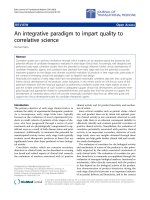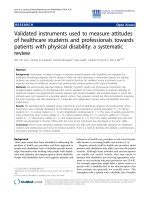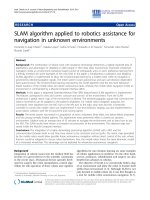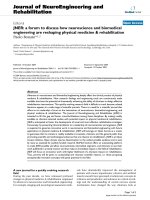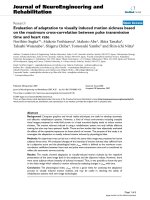báo cáo hóa học: " Occupational allergy due to seafood delivery: Case report" potx
Bạn đang xem bản rút gọn của tài liệu. Xem và tải ngay bản đầy đủ của tài liệu tại đây (196.06 KB, 3 trang )
BioMed Central
Page 1 of 3
(page number not for citation purposes)
Journal of Occupational Medicine
and Toxicology
Open Access
Case report
Occupational allergy due to seafood delivery: Case report
Cornelia S Seitz, Eva B Bröcker and Axel Trautmann*
Address: Department of Dermatology, Venerology and Allergology, University of Würzburg, Würzburg, Germany
Email: Cornelia S Seitz - ; Eva B Bröcker - ;
Axel Trautmann* -
* Corresponding author
Abstract
Background: Sensitization to fish or crustaceans requires intensive skin contact and/or airway
exposition and therefore especially workers in the seafood processing industry may develop an
occupational seafood allergy. However, even in jobs with limited direct exposure, individuals with
atopic disposition not using appropriate skin protection are at risk for developing occupational
seafood allergy which requires termination of employment.
Case presentation: Due to increasing workload and pressure of time a truck driver in charge of
seafood deliveries for 10 years neglected preventive measures such as wearing protective cloths
and gloves which resulted in increasing direct skin contact to seafood or mucosal contact to
splashing storage ice. Despite his sensitization to fish and crustaceans he tried to remain in his job
but with ongoing incidental allergen exposure his symptoms progressed from initial contact
urticaria to generalized urticaria, anaphylaxis and finally occupational asthma.
Conclusion: Faulty knowledge and increased work load may impede time-consuming usage of
preventive measures for occupational health and safety. In predisposed atopic individuals even
minor allergen exposure during seafood distribution may lead to occupational seafood allergy. With
ongoing allergen exposure progression to potentially life-threatening allergy symptoms may occur.
Background
The increase of fish and crustacean allergy in the general
population is mainly attributed to the increased con-
sumption of seafood [1]. Independently, workers in the
seafood processing industry are a population at increased
risk of sensitization due to direct skin contact during han-
dling seafood or inhalation of seafood aerosols e.g. during
cooking or when cleaning storage tanks with pressured
water [2,3]. Here, we report a truck driver who acquired
fish and crustacean allergy by direct skin and mucosal
contact due to unprotected handling of fresh seafood. The
clinical symptoms of his allergy gradually progressed from
contact urticaria to generalized urticaria and later anaphy-
laxis and occupational asthma.
Case presentation
A 47-year-old man had started approximately 10 years ago
as truck driver delivering fish and other seafood stored on
crushed ice. He was in charge of the final quality check of
the delivered seafood which included handling of single
fish of various species and crustaceans. Plastic skirt and
long-sleeved gloves were provided by the employer and
were initially invariably used when handling raw seafood.
But over the years with increased workload and pressure
of time, upon arrival at the client in his rush he frequently
Published: 30 May 2008
Journal of Occupational Medicine and Toxicology 2008, 3:11 doi:10.1186/1745-6673-3-11
Received: 23 October 2007
Accepted: 30 May 2008
This article is available from: />© 2008 Seitz et al; licensee BioMed Central Ltd.
This is an Open Access article distributed under the terms of the Creative Commons Attribution License ( />),
which permits unrestricted use, distribution, and reproduction in any medium, provided the original work is properly cited.
Journal of Occupational Medicine and Toxicology 2008, 3:11 />Page 2 of 3
(page number not for citation purposes)
did not take the time to change and therefore often times
did not wear protecting clothes leading to increased direct
contact with fish, crustaceans, the storage ice, and ice
water.
Two years prior to presentation at our allergy clinic, the
patient first developed itchiness, redness and swelling of
the conjunctivae and eyelids one to two minutes after a
single drop of ice water splashed into his eye. Although
thereafter he tried to strictly avoid skin and mucosal con-
tact, he developed several times within minutes after inci-
dental direct contact to fish, crustaceans, or the storage ice
pruritus, erythema and urticaria restricted to the contact
sites on the hands and forearms. At one instance with
rather intensive contact (carrying a full container by press-
ing it against the lower abdomen) he developed not only
wheals at the contact sites but generalized urticaria. These
symptoms subsided within two hours not requiring spe-
cific therapy.
One year later when consuming a zander/Sander filet
which he had been offered by a client, he suffered from
generalized urticaria with facial angioedema, nausea,
vomiting and defecation. Emergency treatment with intra-
venously applied fluids, H
1
-antihistamines and corticos-
teroids lead to complete resolution of anaphylaxis
symptoms within two hours. Previously, he had only spo-
radically consumed seafood, which he had tolerated until
then without symptoms. After a second episode of gener-
alized urticaria and angioedema after tasting a small
amount of smoked eel/Anguilla and a shrimp/Penaeus
salad he avoided all seafood.
Because of steadily progressive skin symptoms during sea-
food delivery the truck driver was transferred by the offi-
cials of his company to the washing unit of the fish
delivery company where amongst others fish transport
tanks are cleaned with pressured water. There on his first
workday, when cleaning fish transport tanks he developed
dyspnoea with exspiratory stridor. Immediately he
stopped the cleaning procedure and left the room. Due to
the severity of the asthma symptoms emergency treatment
with inhalative and subcutaneously applied β-agonists
was required.
This case illustrates the progression of food allergy symp-
toms depending on the site of allergen contact [4]. Pre-
sumably, percutaneous sensitization occurred by direct
contact of skin and mucosa to fresh seafood stored on
crushed ice because these were the initial sites of contact
urticaria. With ongoing allergen exposure ingestion of fish
and shrimps lead to anaphylaxis before inhalation of sea-
food-aerosols resulted in asthma symptoms.
On physical examination at our allergy clinic several clin-
ical stigmata supporting atopy were observed: dry skin,
keratosis pilaris, pityriasis alba, infrorbital skin fold and
white dermographism. Routine laboratory parameters
were within normal limits. Total serum immunoglobulin
E (IgE) was highly elevated with 1.330 kU/L. Screening
prick testing with inhalative allergens such as pollen, cat
and dog dander, house dust mites and common food
allergens including cow's milk, egg, finned fish, crusta-
cean and hazel nut revealed IgE-mediated sensitizations
against herring/Clupea (after 20 minutes wheal diameter
15 mm) and shrimp/Penaeus (after 20 minutes wheal
diameter 22 mm including pseudopods). During the skin
testing procedure the patient developed generalized pruri-
tus and dyspnoea. These symptoms subsided after treat-
ment with inhalative β-agonists, intravenously applied
H
1
-antihistamines and glucocorticoids. Allergen-specific
serum IgE against herring/Clupea (f205, CAP System,
Pharmacia Diagnostics, Uppsala, Sweden), sardine/Sar-
dina (f308), swordfish/Xiphias (f312) and shrimp/Penaeus
(f24) was measured as 29.2, 6.6, 4.2, and 19.2 kU/L,
respectively.
The most important heat and ingestion resistant fish aller-
gens are parvalbumines, e.g. the 12 kDa muscle protein
Gad c 1 [5]. Approximately 70 % of all patients with fish
allergy develop symptoms to several fish species, the
remaining 30 % react to only one fish species [6,7]. Tro-
pomyosin (Pen a 1), another muscle protein, is the most
important allergen of crustaceans [8]. Cross-reactivities
within several crustacean species are common, therefore
all crustaceans should be strictly avoided. While cross-
reactivity of crustaceans with bony fish (Osteichthyes) is
unlikely, cross-reactivity with mollusca (e.g. bivalvia),
insecta (e.g. cockroach) and arachnida (e.g. house dust
mites) are possible [9].
Due to typical clinical symptoms after exposure to sea-
food and positive test results diagnosis of IgE-mediated
allergy to finned fish and crustaceans was established. The
patient's allergy to crustaceans and finned fish was recog-
nized as an occupational disease. Cause for sensitization
was probably the ongoing skin contact to native fish and
crustaceans for years. Sensitization was facilitated by irri-
tative factors such as wet and cold working conditions (ice
water) as well as his atopic background with consecutive
disturbance of the physiologic skin barrier function. It has
been shown that storage conditions may influence the
skin irritancy of fish juice; fish kept on ice for several days
enhances frequency and severity of symptoms such as
itching, stinging, and erythema [10]. However, the most
important risk factor for IgE sensitization against fish and/
or crustacean proteins is atopy [11]. In a recent study of
employees in the seafood processing industry skin symp-
toms were predominantly moderate and seldom inter-
Publish with Bio Med Central and every
scientist can read your work free of charge
"BioMed Central will be the most significant development for
disseminating the results of biomedical research in our lifetime."
Sir Paul Nurse, Cancer Research UK
Your research papers will be:
available free of charge to the entire biomedical community
peer reviewed and published immediately upon acceptance
cited in PubMed and archived on PubMed Central
yours — you keep the copyright
Submit your manuscript here:
/>BioMedcentral
Journal of Occupational Medicine and Toxicology 2008, 3:11 />Page 3 of 3
(page number not for citation purposes)
fered with working capacity [3]. However, in our case due
to the severity of allergy symptoms, including generalized
urticaria and asthma, there was a need for termination of
the hazardous occupation, which in German jurisdiction
is a crucial requirement for approving a condition as an
occupational disease [12,13]. In case of accidental aller-
gen contact leading to anaphylaxis the patient received
emergency medication including an epinephrine-contain-
ing autoinjector and was instructed on the usage [14].
Conclusion
The significance of the skin for general health is often
underestimated. However, in Germany e.g. in 2005
approximately 9.500 cases of occupational skin diseases
were among a total of 25.000 approved occupational dis-
eases [13]. Not always the lack of information concerning
the necessary protection measures is responsible for the
large number of occupational skin diseases. Our patient, a
truck driver liked his job as delivery man and initially
accurately used protective clothes. However, increased
pressure of time and the necessity to constant rush, more
and more lead to neglect of necessary protection meas-
ures.
Competing interests
The authors declare that they have no competing interests.
Authors' contributions
CS carried out testing of the patient and participated in
study design and coordination as well as drafting of the
manuscript, EB participated in the design of the study and
helped to draft the manuscript, AT conceived of the study,
participated in its design and coordination and drafted
the manuscript. All authors read and approved the final
manuscript.
Consent
Written informed consent was obtained from the patient
for publication of this case report. A copy of the written
consent is available for review by the Editor-in-Chief of
this journal.
References
1. Ree-Kim L, Lehrer SB: Seafood allergy. Curr Opin Allergy Clin Immu-
nol 2004, 4:231-234.
2. Jeebhay MF, Robins TG, Lehrer SB, Lopata AL: Occupational sea-
food allergy: a review. Occup Environ Med 2001, 58:553-562.
3. Aasmoe L, Bang B, Andorsen GS, Evans R, Gram IT, Lochen ML: Skin
symptoms in the seafood-processing industry in north Nor-
way. Contact Dermatitis 2005, 52:102-107.
4. Sicherer SH, Sampson HA: Food allergy. J Allergy Clin Immunol
2006:470-475.
5. Van Do T, Elsayed S, Florvaag E, Hordvik I, Endresen C: Allergy to
fish parvalbumins: studies on the cross-reactivity of allergens
from 9 commonly consumed fish. J Allergy Clin Immunol 2005,
116:1314-1320.
6. Helbling A, Haydel R, McCants ML, Musmand JJ, El Dahr J, Lehrer SB:
Fish allergy: is cross-reactivity among fish species relevant?
Double-blind placebo-controlled food challenge studies of
fish allergic adults. Ann Allergy Asthma Immunol 1999, 83:517-523.
7. Sten E, Hansen TK, Stahl SP, Andersen SB, Torp A, Bindslev-Jensen U,
et al.: Cross-reactivity to eel, eelpout and ocean pout in cod-
fish-allergic patients. Allergy 2004, 59:1173-1180.
8. Leung PS, Chen YC, Chu KH: Seafood allergy: tropomyosins and
beyond. J Microbiol Immunol Infect 1999, 32:143-154.
9. Reese G, Ayuso R, Lehrer SB: Tropomyosin: an invertebrate
pan-allergen. Int Arch Allergy Immunol 1999, 119:247-258.
10. Halkier-Sorensen L, Thestrup-Pedersen K: Skin irritancy from fish
is related to its postmortem age. Contact Dermatitis 1989,
21:172-178.
11. Desjardins A, Malo JL, L'Archeveque J, Cartier A, McCants M, Lehrer
SB: Occupational IgE-mediated sensitization and asthma
caused by clam and shrimp. J Allergy Clin Immunol 1995,
96:608-617.
12. Belsito DV: Occupational contact dermatitis: etiology, preva-
lence, and resultant impairment/disability. J Am Acad Dermatol
2005, 53:303-313.
13. Drexler H: [Skin and occupation]. Dtsch Med Wochenschr 2007,
132:251-252.
14. Simons FE: Anaphylaxis, killer allergy: long-term management
in the community. J Allergy Clin Immunol 2006, 117:367-377.

